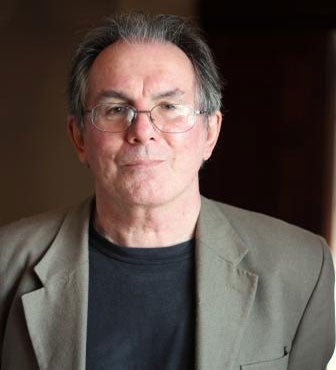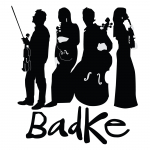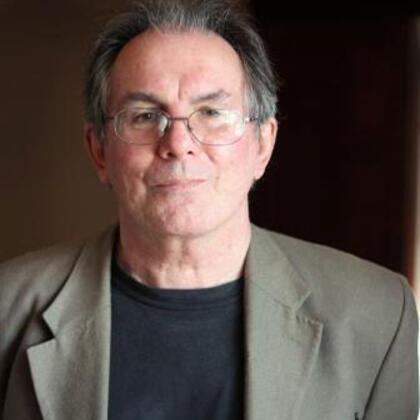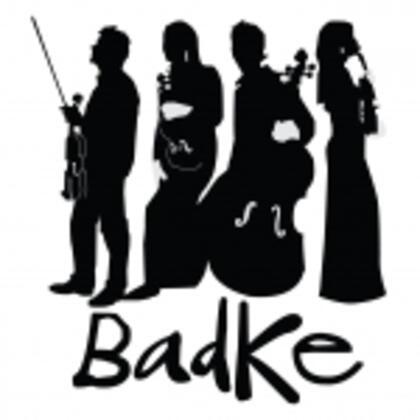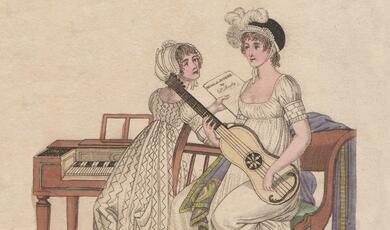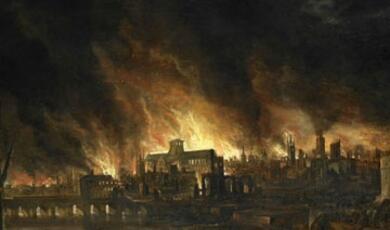Joseph Haydn, Op 76 No 2 in D minor
Share
- Details
- Text
- Audio
- Downloads
- Extra Reading
This quartet is sometimes known as the "Quinten" or "Fifths" Quartet, because of the opening descending intervals in its first movement. This movement is tightly structured around the "fifths" motive, and shows Haydn at his most austere and monothematic. Respite comes in the gentle second movement, but the third (a minuet and trio) returns us to the mood of the first, with a severe canon between the upper and lower instruments.
Download Text
Haydn: Quartet Op. 76 No. 2
Professor Roger Parker
10/02/2010
I closed the first lecture in this series with some ruminations (I hope nottoo pious) about the spirit of communication that, to me, is such an essential a part of these Gresham lectures: the fact that we can talk about the music, and then hear it played complete, and then have a period in which you the audience can question me or the Badke quartet. And it's in that spirit that I'd like to follow up on a couple of the questions asked at the last lecture, which was on Haydn's Quartet Op. 76 No 1, and see if I can answer them a little more fully, before One question was about Haydn and what might best be called his 'musical personality'. I spent some time in the last lecture talking about the great triumvirate of composers to whom we're dedicating this series-Haydn, Mozart and Beethoven-and how essential they all are to the status that the string quartet acquired in the nineteenth century, and still to some extent maintains today. Someone asked about the relative reputations of these three composers, and why it was and is that Haydn has somehow never been as well celebrated (or, at least, as elaborately worshipped) as the other two. There are lots of answers to this question: matters of reception are always damnably complicated, particularly when, as in this case, they spread over vast stretches of time and involve many different countries. What's more, we should never forget the importance that sheer accident can have on a composer's (or, for that matter, anyone else's) reputation. Mozart died young and happened to write Don Giovanni, an opera whose subject-matter was peculiarly well suited to survival during the nineteenth century. Without these ticks against his name, would he have sustained the reputation he did through the hundred years after his death? No-one knows. But in other circumstances he might well have been placed in the same category as Haydn: as a pleasing composer, and an important warm-up act for Beethoven, but hardly a true 'romantic'. On the other hand, if Haydn had died at Mozart's age, he would have remained a minor figure, perhaps celebrated as Gluck is today: as an interesting 'transitional' figure, but no more than that.
What's certain, though, is that Haydn got fixed in his slot very early on, almost immediately he had died. In one of the most influential pieces of early nineteenth-century music criticism, a piece on Beethoven's instrumental music written around 1810, that poster-boy of Romanticism E.T.A. Hoffmann was already celebrating the Haydn-Mozart-Beethoven trio, and indeed calling the instrumental music they wrote, with gushing exaggeration, 'the most romantic of all the arts-one might almost say the only romantic one-for its sole object is the infinite. The lyre of Orpheus opened the portals of Orcus-music discloses to man an unknown realm, a world that has nothing in common with the external sensual world that surrounds him, a world in which he leaves behind him all definite feelings to surrender himself to an inexpressible longing'. Yes indeed, when it came to gushing, those romantics would bow to no-one.
Hoffmann had no difficulty dealing with Mozart and Beethoven in this kind of language. Mozart 'leads us into the heart of the spirit realm: night come on with a bright purple luster, and with inexpressible longing we follow those figures which, waving us familiarly into their train, soar through the clouds in eternal dances of the spheres'. And Beethoven, well, 'burning flashes of light shoot through the deep night of this realm, and we become aware of giant shadows that surge back and forth'. In this context, though, Hoffmann's ventilations about Haydn, which are even longer, betray a slight difficulty. Let me quote at some length:
In Haydn's writing there prevails the expression of a serene and childlike personality. His symphonies lead us into vast green woodlands, into a merry, gaily coloured throng of happy mortals. Youths and maidens float past in a circling dance; laughing children, peering out from behind the trees, from behind the rose bushes, pelt one another playfully with flowers. A life of love, like that before the fall, of eternal youth; no sorrow, no suffering, only a sweet melancholy yearning for the beloved object that floats along, far away, in the glow of the sunset and comes no nearer and does not disappear-nor does night fall while it is there, for it is itself the sunset in which hill and valley are aglow.
I hope I won't seem too disrespectful to romantic reverie here if I suggest that Hoffmann's showing signs of desperation here (those children pelting each other with flowers is probably the low point). There seems to be something about Haydn's music that stubbornly won't get co-opted into the romantic ideology, and so Hoffmann is obliged to reach back for imagery that places the composer as both too young and innocent, and also (curiously) as the beautiful remnant of a past age (the sunset imagery). Hoffmann's strain was typical of the nineteenth century, which was a lean one for Haydn. Those grand choral works he wrote in later life retained a hold in the repertory of several countries, but his symphonies and quartets, although respected and even revered for their evident proximity to Mozart and Beethoven, were forever thought of as in some way preliminary to those of the great masters to come.
The decisive turn in Haydn's fortunes came in the early twentieth century, and can probably be understood as part of the same wave that produced so-called 'neo-classicism', or perhaps even musical modernism more generally. Suddenly, Haydn's clarity, craftsmanship and industry, not to mention the fact that he had resisted co-option into the now detested romantic ideology, became aspects to celebrate. This was not, I'm afraid, all good news. We may smile now at Hoffmann's language. But the new celebrations of Haydn as a genius of abstract structure and formal clarity gave rise to another kind of excess, one that turns out to be even harder to read. A brief example. If you were here for the last lecture, then you'll remember the final movement of Op. 76, No. 1, with its aggressive unisons. Here's just some of the discussion of the opening in Hans Keller'sThe Great Haydn Quartets:
It must be admitted upon reflection that the octave unison with which the finale starts is itself an introduction; it has gone entirely unobserved, because nobody has expected Haydn to extend his variations on the theme of the introduction to the last movement...When it happens, it has to be played as what it is-a downright structural miracle. It is, of course, strictly and overtly thematic'so much so that countless analysts have described it as the first subject which, in reality, starts after the introduction is over, with the viola's upbeat to bar 7.
And that's just the chatty beginning, before the heavy lifting equipment arrives and the real analysis begins. The modernist musical obsession with form, 'structure', thematic webs, harmonic patterns and-above all-transcendent unity may have done a great deal to raise Haydn's intellectual prestige, but it did so at a considerable cost-not least of which was the comprehensibility of its purveyors to most of the music-going public.
Such language is now itself out of fashion in the academic citadel, although its traces still remain in more humble venues. If you look up the Wikipedia article on today's quartet (and of course I apologise immediately for even mentioning so prosaic and unreliable source to an audience as sophisticated as this one), you'll find nothing more that a distillation of the old formalist jargon; a bare-bones account of the sonata-form outlines and the tonal maps of each movement. Hoffmann's lubrications seem to float free entirely from any specific musical substance (they could, one feels, be about almost any music, and depend mostly on the mood and preconceptions with which the writer is preoccupied); this latter-day, formalist approach to Haydn seems, on the other hand, to demand another kind of abstraction-above all one not geared to listening to the quartet, but to reading it: examining a copy of score, in which all those motivic derivations and tonal shifts are so much more obvious and traceable than they are in performance.
I've described this latter, score-based approach to Haydn (and of course the point could be made about many other 'classical' composers) as something chiefly stemming from modernism and the twentieth century, but the roots of its approach go back quite a long way, and are perhaps worth a digression. I was stuck recently by an account of musical life in 1830s London. What was new in this period, as perhaps befitted that pragmatic, reformist decade in British political culture, was the decisive emergence and growing self-confidence of a new audience for classical music, one that preferred concerts of instrumental music (a new phenomenon) to the older attractions of the operatic season. This story has often been told, but the attitudes and behaviour attendant on it may still benefit from rehearsal. As many have said, spectator silence was an important ingredient at these new instrumental-music concerts, and became intimately associated with a new humility to the composer, deference to elevated reputations, and a desire for self-improvement. Discussing a concert 'in the East End of London' that contained works by Haydn, one contemporary critic opined that 'if [the audience] could not appreciate those compositions, (which was scarcely to be expected) they nevertheless were content to take their merit upon trust, and to subject their own understandings to the discipline of an acknowledged and chastised taste'. Another spilled over into missionary zeal when enthusing over what the performers could achieve:
They were not merely providing a cheap enjoyment for multitudes, of the most unquestionable character, but they were diffusing a refinement of taste, and a power of appreciation, which belongs to the best agencies of civilization. They were in fact, though not in form, a Mission for elevating the taste, and by that for elevating the moral improvement, of the middle classes of society.
This attitude, in particular of quasi religious reverence before the musical object, of the new rituals of concert-going, was enthusiastically extended to the fastest-growing type of concert in the 1830s, which was that featuring German instrumental music, string quartets included. In stark contrast to the noisy opera house, which thrived on novelty, here sameness was actively promoted and celebrated. When the Philharmonic Society in 1838 had the temerity to feature a work by George Onslow (who of course had the misfortune of being partly French), it was roundly castigated:
No band in this country can do such justice to Mozart, Beethoven, and Spohr, as that of the Philharmonic. Herein rests their glory, and until they have produced all the works of these composers, and by repeated performances rendered them as familiar as household gods, we very readily give up all curiosity with regard to [minor composers].
One agent of this new economy brings us very close to home. In November 1836 the composer and lecturer Charles Purday wrote a letter to a prominent musical journal, aptly and imperialistically known as The Musical World, pointing out the 'inattention observable in [the] conduct' of audiences at certain instrumental concerts. His remedy was a novel one (if, given his profession, not entirely disinterested): it was to 'render musical performances as intellectual as they are sensual'. This would be achieved if a 'prologue...should preface every performance of the works of the great masters, giving brief and pithy analysis of the composition to be performed'. As least so far as I know, this revolution did not immediately come about; but there is no doubt that what we might call score-based exegesis was also on the rise. The Gresham College lectures in music, which had been a London institution since the sixteenth century, took a decisive new turn in 1838. Instead of narrow technical matters directed towards budding composers, the Gresham Professor of the day decided that 'the real benefit of music lectures consists in the extension and enlightenment of the musical public-and these purposes will be always answered, when a conscientious musician, earnest in the cause which he advocates, endeavours to influence the thoughts and feelings of his audience in behalf of that which is really good, by setting before them, in as complete a state as possible, a series of choice compositions-. Professors of music were, in other words, on the march; and they armed themselves with a potent new scripture, one engraved with musical notation.
We're come a long way since those days, although-as you can see-the similarities of then and now are still striking, suggesting how long the present-day rituals of 'classical' concerts have been with us, and'some may feel-how ossified they have become. (On the other hand, I hear others cry, isn't ossification one of the points of rituals?) The main task, at least for me, is to try to find some way of characterising the musical substance of the quartet in question that will be an aid in listening: one that avoids the flowery fantasies of E.T.A. Hoffmann on the one hand and the austere, score-based dissections of Hans Keller on the other. So what's the best way forward? Instead of attempting anything like a narrative approach, one that inevitably seems to rely on 'score-based' tactics, I want to experiment today with concentrating on just four moments: the starts of each movement.
I mentioned in the first lecture how the first quartet in the series, Op. 76 No. 1, seems to lay out its stall in a very obvious, 'public' manner at the start of the first movement: announcing with three loud, gesturally expansive chords, the opening of proceedings. In this sense, Op. 76 No 2 is in stark contrast. It begins in a severe, dark-toned minor mode, the first violin announcing a stark, four-note motive made up of two descending fifths, with the other instruments providing a functional accompaniment. It will soon become clear to you that this opening motive dominates the entire movement, and a hair-shirted pleasure might be taken from locating all its various transformations: into the bass, upside down, with its rhythm intact but its melodic profile changed, in faster notes, in counterpoint; and so on and on. If you did listen like this, you might even come to the conclusion that the movement is too unified, that it's what a psychologist would call over-determined; so also enjoy the evident contrasts of the movement, in particular (a general feature of the work as a whole) the manner in which Haydn sends the first violin periodically into the stratosphere.
Movement 2, an Andante, is the greatest contrast imaginable. A simple, lightly ornamented melody in the first violin is accompanied by pizzicato lower strings, evidently in imitation of the 'light' genre from which the string quartet emerged. Although there are moments of interest for the other instruments, this is something like an 'aria' for the first violin, more akin to a variation movement than anything else.
Movement 3, a minuet and trio, launches us back into austerity-the mood and key of the first movement. Its texture is the most severe imaginable. The four instruments are divided into two pairs (two violins on one side, viola and cello on the other); both pairs play in octave unison and are set in angry canon with each other. The effect so extraordinary-so angular and so bare-that it sounds as though Haydn is deliberately making the point that in his hands the quartet has an enormous variety of combinations at its disposal: from the simple voice-and-accompaniment of the slow movement to the present uncompromising severity. As so often in late Haydn, the route to late Beethoven is suddenly made obvious. I read somewhere that this third movement has been called the 'witches' minuet' (Hexenminuett); if this encourages you to imagine cauldrons and pointed black hats, then so be it: quite why, though, witches would indulge in such strict counterpoint poses something of a challenge, as does inventing a suitable programme for the strongly contrasting trio.
The last movement announces another wild change, into a musical atmosphere that would have been recognised as 'exotic' or 'folk-like' by its first hearers, and that probably gestures towards Hungarian idioms. It too, some of you will be pleased to hear, has a nickname: it's know as 'The Donkey', and I won't insult you by pointing out why.
And so we have it. Another quartet that covers an enormous distance by means of its four movements: from the most demanding and developed of 'modern' styles in the first movement, to lighter gestures in the second, to strange, alienating originality in the third, and to a national-idiom 'character piece' in the last. These contrasts make enormous demands on the performers, reminding us once more that the string quartet, which had come from such humble beginnings a few decades previously, had now, in the hands of Joseph Haydn, become a musical vessel of tremendous potency. Here play it for us Haydn's Op. 76 No 2 is the Badke Quartet. Please join me in welcoming them: Heather Badke, first violin; Emma Parker, second violin; Jon Thorne, viola; and Jonathan Byers, cello.
Badke Quartet plays
©Professor Roger Parker, Gresham College 2010
Part of:
This event was on Wed, 10 Feb 2010
Support Gresham
Gresham College has offered an outstanding education to the public free of charge for over 400 years. Today, Gresham College plays an important role in fostering a love of learning and a greater understanding of ourselves and the world around us. Your donation will help to widen our reach and to broaden our audience, allowing more people to benefit from a high-quality education from some of the brightest minds.


 Login
Login
